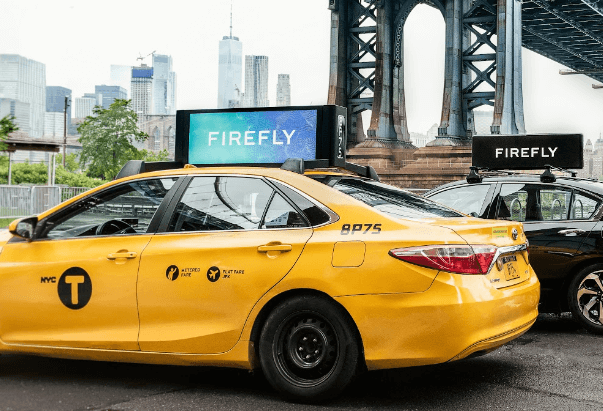Firefly ups the ante for digital out-of-home
Firefly's "taxi-top" dynamic screens bring programmatic inventory together with precise location targeting and measurement.
Perhaps you’ve seen digital out-of-home (OOH) media platform Firefly’s “taxi-top” screens in San Francisco, New York or Los Angeles and wondered, “how can they measure a moving target?” That was my question until I spoke with Firefly Chief Analytics Officer (and former Googler) Taylan Yildiz.
Yildiz says that not only are Firefly’s screens are measurable but that the company’s targeting and attribution are highly precise and reliable. He also talked to me about the dynamic geo-targeting capabilities of the moving digital screen that neither traditional OOH nor digital (but stationary) OOH screens can match.
Helping drivers earn more money
Firefly, which launched at the end of last year and has raised more than $50 million to date (with Google parent, Alphabet, as an investor), aims to put its digital screens on top of every cab, Uber or Lyft in America. (There are more than 2 million Uber and Lyft drivers in the U.S., not accounting for overlap.) The pitch to drivers is that they can make 20% more income, passively, by mounting the screen on top of their vehicles as they drive.
One of the tactics that has greatly aided traditional billboards and other OOH advertising has been the pairing of these fixed placements with mobile-location data to match media exposures with offline consumer behaviors. Location intelligence companies can determine the mobile ad IDs that were exposed to the OOH placement and then whether those devices showed up in a store, for example, a week later.

Better control groups
In other to determine actual visitation lift, there must be both a control and exposed group. Yildiz asserts it’s almost impossible with traditional (or digital) OOH to find an unbiased control group. It’s difficult to find a control group that is close enough to the exposed group, he argues; because you have to find other commuters or pedestrians on another highway or alternative, comparable location to validate that the media exposure was truly responsible for the later consumer action.
We can debate this assertion, but Firefly says its control groups have zero bias and are identical to the exposed groups. They’re drivers or pedestrians present in the same locations immediately before and after the appearance of the vehicle with Firefly screen.
Using the control-exposed methodology, the people (ad IDs) exposed to the 8-second ad on top of the car, which cannot be skipped, can then be tracked to a store during a trailing attribution window. But they can also be tracked to a subsequent website visit or an app-store download or an online, ecommerce transaction. In other words, Firefly advertisers can run a brand awareness campaign and then measure site traffic lift as a result of that campaign.
Customers exposed to Firefly can also be retargeted on other digital media.
Targeting: commute patterns and geozones
I asked Yildiz about audience targeting. How can the company be confident about reaching specific audiences given the dynamic nature of the media? Everyone in the immediate area is going to see the ad.
He said the company uses third party data that offers predictive insights into location-based audiences and commute patterns. In addition, he says, Firefly can predict available impressions. The company says it currently serves roughly 430 million impressions per month in the cities in which it operates. That will grow as it adds new cities and more drivers.
A retailer or brand can advertise within a precise radius of its own locations or stores where its product can be purchased (like geofencing on mobile). Marketers can do conquesting in the same way by advertising around competitor stores. Firefly will turn ads on and off as cars enter or leave designated geozones.
Branding, direct response or both
Firefly is making its inventory available to the programmatic ecosystem but also sells direct to brands and marketers. Yildiz also explains Firefly will ultimately be able to target and measure ads in real-time.
As a final point, I raised to question of whether marketers should regard the platform as a direct response or branding medium? Traditional OOH is generally about branding or awareness. But the dynamic creative, retargeting and measurement capabilities Firefly offers make it potentially very appealing as a performance channel.
Of course, the answer is “both,” according to Yildiz, who says the company has the ability to sell ads on a CPA basis. However, it currently sells on CPM.
Taxi-top ads date from the 1970s. And digital ads on busses, trains and taxis have been around for some time as well. But the combination of digital OOH, programmatic inventory, dynamic geotargeting and precise measurement capabilities are something new.
Contributing authors are invited to create content for MarTech and are chosen for their expertise and contribution to the martech community. Our contributors work under the oversight of the editorial staff and contributions are checked for quality and relevance to our readers. The opinions they express are their own.
Related stories